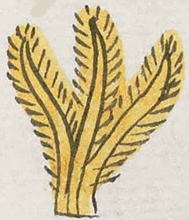Zacatla (Mdz40r)
This simplex glyph, standing in for a compound glyph of zacatl) (grasses) and -tlan (locative suffix, not pictured), consists of three fluffy stalks of grasses painted yellow.
Stephanie Wood
Here we accept the -tla (place of abundance of) locative suffix as indicated by the gloss. Showing the glottal stop at the end, it could be written -tlah. Of course, it could also be that the locative suffix has dropped the final "n," and if it had one, then the "abundance" dimension would not be relevant here.
Stephanie Wood
çacatla. puo
Zacatla, pueblo
Stephanie Wood
c. 1541, or by 1553 at the latest
Stephanie Wood
grasses, zacates, nombres de lugares

zaca(tl), grasses, hay, fodder, https://nahuatl.wired-humanities.org/content/zacatl
-tla (locative suffix), place of abundance of, https://nahuatl.wired-humanities.org/content/tlan
"Where There is Much Grass" (apparently agreeing with Berdan and Anawalt) [Frances Karttunen, unpublished manuscript, used here with her permission.]
"Where There is Much Grass" (Berdan and Anawalt, 1992, vol. 1, p. )
"El Lugar Con Mucho Zacate"
Stephanie Wood
Codex Mendoza, folio 40 recto, https://digital.bodleian.ox.ac.uk/objects/2fea788e-2aa2-4f08-b6d9-648c00..., image 90 of 188.
The Bodleian Libraries, University of Oxford, hold the original manuscript, the MS. Arch. Selden. A. 1. This image is published here under the UK Creative Commons, “Attribution-NonCommercial-ShareAlike 3.0 License” (CC-BY-NC-SA 3.0).

